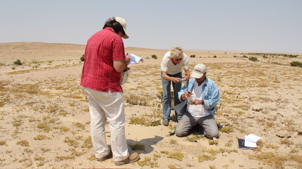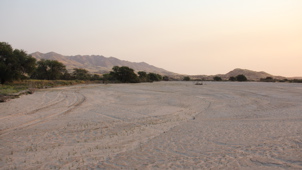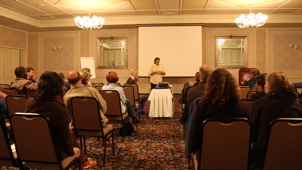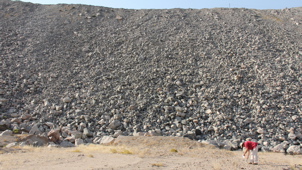
Radiation monitoring experts from France went on a mission to Namibia to work with activists and communities on uranium mining in their area. The objective was to increase the awareness about the impacts of uranium mining.
EJOLT – CRIIRAD visits Namibia
 Our expedition comprised of Bruno Charyeron and Christian Courbon from CRIIRAD. They arrived to sunny Windhoek 19th of October. We were received by Bertchen Kohrs, the director of Earthlife Namibia, also a partner of EJOLT.
Our expedition comprised of Bruno Charyeron and Christian Courbon from CRIIRAD. They arrived to sunny Windhoek 19th of October. We were received by Bertchen Kohrs, the director of Earthlife Namibia, also a partner of EJOLT.
CRIIRAD is an independent research organisation specialized in radioactivity. Their main task is to increase the awareness of the impacts of ionizing radiation, especially on human health. That is what brought us here. Earthlife together with another local NGO named LaRRI staged a campaign in 2008 denouncing the uranium mining expansion, the environmental impact and the health situation of several mine workers.
Namibia is an arid scarcely populated country with few water sources and with a troubled history having gone through a long colonization process and Apartheid, only acquiring independence from South Africa in 1990. This long colonization period was partly motivated by Namibia’s rich resources. Diamonds have been for long a strong contributor to the economy but since the 2008 crisis when the diamond price plummeted, uranium has become the hot commodity. One mine opened in 2007 (Langer Heinrich) and between 2 and 5 are expected to open in the coming years.
However, uranium is not new to Namibians, in the context of the apartheid regime, Rio Tinto opened a mine in 1976 named Rössing Uranium Mine. To house its workers, Rössing built a town, Arandis, 13km from the mine.
Are Rössing workers aware of the radiation implication of their work environment? Are the workers from Rössing getting sick? Is Arandis at risk of being contaminated? Is the underground river near Rössing at risk? These are the questions that brought our expedition to this region.
We have several tasks to carry out in this visit to Namibia. We want to find out what is the situation on the ground. We want to inform people about the radiation and the impacts of uranium mines and we want to create a local network within the impacted areas in order to keep an independent monitoring program.
The second night in Windhoek we attended a public meeting of the Gecko project, an industrial project to be located at the coastal area near the uranium mines (close to Swakopmund). The project envisages to produce the reagents needed by the uranium mines thus avoiding import of the reagents and collapsing further the port. They are planning to develop a sulphuric acid plant, a phosphoric acid plant, a soda ash plant, a port and (to feed the plant ; a limestone mine, phosphate harvesting from the ocean, a caustic plant, a salt mine and a desalination plant.
A concerned group of people living in Swakopmund have reacted strongly against this project. The Gecko team assured in the meeting that if it was proven through the EIA process that the project could cause health impacts or affect the environment in a way that it could not be offset or minimized, they would not go ahead. Although the Gecko project is not exactly part of our mission, it emphasises the urgency of action.
We left for Swakopmund the next day. All the uranium mines are located east of this town and many people working for the mines live there. Swakopmund is a small tourist town (42,000 pop.) with many people coming to retire; the black community lives in the old township (Mondesa) and in new areas with informal housing (DRC). Many of the people in the town work for the tourist sector. The main attraction to the area however is the protected Namib Naukluft National Park and the newly created Dorob National park.
With Georg Erb, who makes desert tours around the area, we went to the area surrounding Rössing Mine. The following day, we went to the north of the Namib Naukluft National Park, it’s a dramatic beautiful area, with desert and rocky landscape. One of the most spectacular sites is the Moonlandscape, next to Goanikontes. Bannermans, an Australian mining company, wants to start mining uranium in this area. . At different locations the CRIIRAD team made radiation measurements with a professional scintillometer and took samples of water, surface soil and or sediments. The gamma radiation readings obtained were compared with the ones given by a radiation meter that CRIIRAD gave to Earthlife in the context of the EJOLT project.
Further inland into the park, we drove through the now-closed-to-the-public road to Langer Heinrich. This is the second mine in Namibia, opened in 2007 by Paladin Energy, also an Australian company. It is located in the Gawib river, a subsidiary of the Swakop river. The Swakop river runs all the way to the coast; it has high salt concentration , so it is not used for human consumption. We learnt however that it was used a few decades ago by local residents. Currently its only used by few farmers closer to the coast for irrigation of olive trees and asparagus.
 During the weekend we went to Arandis. On Monday 26th a workshop took place in the Catholic Church. Some concerned citizens were informed by Bruno about radiation, its impacts and how to measure radiation. We talked with former and present workers and their wives. Several people told us that lately the safety procedures had improved greatly at the mine, however during the initial years of the mine, safety masks were either not used or not enforced and workers were not aware about the impacts of radiation. Although the situation has improved, the workers might not yet fully understand basic concepts about radiation and the health risks of working in a uranium mine. The objective is not to discourage them from working in the mine, but to raise their awareness so that they can protect themselves more effectively.
During the weekend we went to Arandis. On Monday 26th a workshop took place in the Catholic Church. Some concerned citizens were informed by Bruno about radiation, its impacts and how to measure radiation. We talked with former and present workers and their wives. Several people told us that lately the safety procedures had improved greatly at the mine, however during the initial years of the mine, safety masks were either not used or not enforced and workers were not aware about the impacts of radiation. Although the situation has improved, the workers might not yet fully understand basic concepts about radiation and the health risks of working in a uranium mine. The objective is not to discourage them from working in the mine, but to raise their awareness so that they can protect themselves more effectively.
Next day, on Tuesday 27th Bruno gave another lecture in Swakopmund. He informed people about radiation and the impacts of uranium mining and nuclear energy based on CRIIRAD’s previous work in France and Africa. Representatives from Rössing were also present at the discussion and exchanged comments with Bruno, it was a very interesting lecture!
 In the afternoon we visited the recently established Uranium Institute, a center that aims to promote a safe uranium industry in Namibia, exclusively sponsored by the uranium mining companies. We met with the director of the institute, Dr Wotan Swiegers. He used to be the medical doctor responsible for the health of the Rössing mine workers for some decades. He gave us very general information but was not able to answer Bruno’s detailed questions such as the degree of contamination of underground water , the dose rate near the drums containing yellow cake, the amount of radioactive dust and radon gas near the tailings dam, the radiological consequences for the people that stole yellow cake a year ago, etc..
In the afternoon we visited the recently established Uranium Institute, a center that aims to promote a safe uranium industry in Namibia, exclusively sponsored by the uranium mining companies. We met with the director of the institute, Dr Wotan Swiegers. He used to be the medical doctor responsible for the health of the Rössing mine workers for some decades. He gave us very general information but was not able to answer Bruno’s detailed questions such as the degree of contamination of underground water , the dose rate near the drums containing yellow cake, the amount of radioactive dust and radon gas near the tailings dam, the radiological consequences for the people that stole yellow cake a year ago, etc..
The team was also joined for some days by Salvador, a young co-worker from LaRRI, keen to learn about uranium mining, radiation and it’s impacts. We still need to see how we can make use of his great communication skills. On Friday, the team visited the waste rock dump of Rössing which is not protected even by a fence. Waste rock is the portion of rocks with low uranium grade, it is therefore not processed but still contains uranium. The main risk, as Bruno explained, is the utilization of these rocks by the public or even by the mine for construction of roads, parking areas etc, as was done by Areva in France. The team also monitored the impact of the waste rock dump: radon gas in the air, transfer of radioactive minerals to the surrounding soil, elevated dose-rate when getting close to the radioactive rocks.
 On Saturday 1st we visited the Shalom market, located at a charming spot upstream near the Swakop river where people gather on Saturday mornings to have breakfast and purchase local products grown near the river. For most vegetables municipal water is used for irrigation, except for the asparagus and olive trees, as they tolerate high salinity.
On Saturday 1st we visited the Shalom market, located at a charming spot upstream near the Swakop river where people gather on Saturday mornings to have breakfast and purchase local products grown near the river. For most vegetables municipal water is used for irrigation, except for the asparagus and olive trees, as they tolerate high salinity.
Back in Windhoek, another lecture was given by Bruno. A film produced by a French journalist, M Dominique Hennequin showing the impacts of uranium mining in Gabon and Niger was also shown. Although it was acknowledged that the situation in these countries is different to Namibia, it indicated the main topics where uranium mining can impact and which questions need to be asked and addressed.
As we leave Namibia, we reflect on what has been achieved and what we have learnt. Bruno and Christian from CRIIRAD now have more information about the area surrounding the mines, and they have been in contact with the local population. They have been able to share their knowledge with several people of different communities, having increased their awareness about radiation and the implications of uranium mining.
Now Bertchen, together with other Earthlife members and other people that have shown interest in the topic can follow up the case. Currently they are busy compiling a set of questions that will be sent to the mining companies via Dr. Swiegers. The answers will help understanding the situation and analyze whether the mining company’s operations and monitoring are well managed. CRIIRAD is now processing the samples of sediments, surface soil and water collected during the mission to Namibia in order to gather independent information.

The project ENVJUSTICE has received funding from the European Research Council (ERC) under the European Union’s Horizon 2020 research and innovation programme (grant agreement No. 695446)